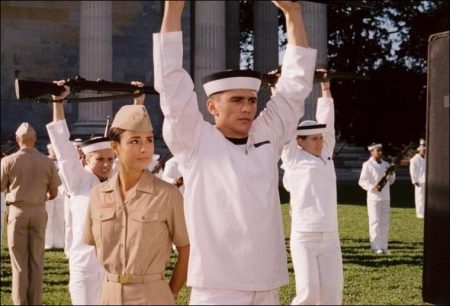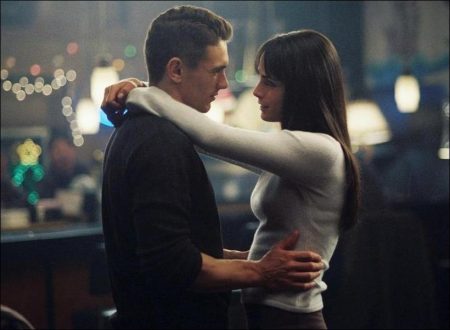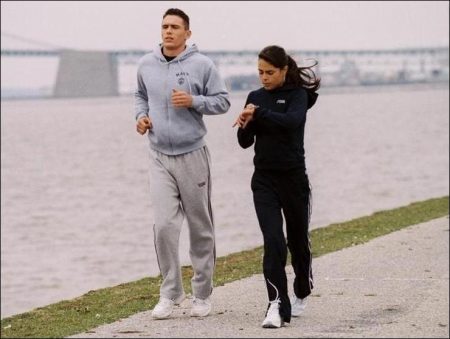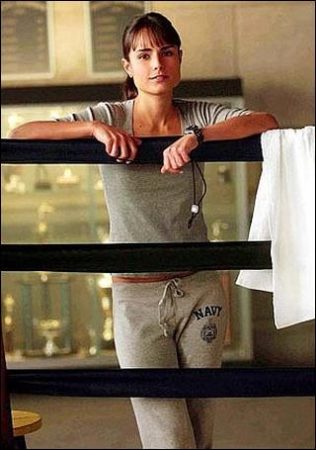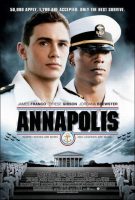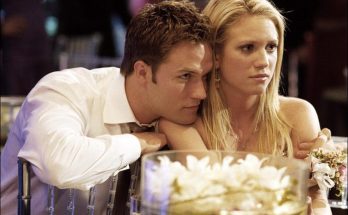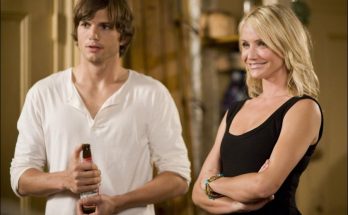Tagline: Where heroes are born and legends are made.
“You ain’t good enough” — Midshipman Lt. Cole
“I’m not quitting” — Jake Huard, Annapolis Plebe
It’s known as one of the toughest institutions in America—a home for the best and brightest who are driven to serve their country and a training facility where only the strongest survive. It’s a rarified world that, by necessity, makes or breaks tomorrow’s heroes. And for local Maryland kid Jake Huard, the United States Naval Academy at Annapolis has been a lifelong dream he never thought could come true. Only now that it has, he is about to realize that his battle to become the man he always wanted to be is only just beginning.
Jake (James Franco) was raised to believe his future lay as a laborer in the Annapolis shipyards—like everyone else in his family before him. But to his disbelief, Jake has defied the odds and become one of the rare few accepted to Annapolis along with some of the most elite young people in the country.
When he arrives, his dream soon looks like it might turn into a nightmare. As a freshman “plebe,” Jake is immediately thrown into a pressure-cooker atmosphere that threatens to be his undoing. Just as it seems Jake could become another Annapolis statistic, he takes one last shot at proving his potential. He meets an unlikely ally in his beautiful, stunningly strong military superior, Ali (Jordana Brewster), who also happens to secretly be a skilled boxing trainer.
Jake decides to train for the legendary Navy boxing competition, a creator of future leaders known as the Brigade Championships. Now, there remains only one thing standing between Jake and the triumph he needs—the steel-jawed company commander, Midshipman Lt. Cole (Tyrese Gibson). Everything Jake has ever hoped for stands in the balance—the chance to make his father proud, the chance to stand up for his fellow plebes and, most of all, the opportunity to fight for a better future.
Welcome to Annapolis
Each year approximately 50,000 hopeful young men and women apply to enter the venerated 160-year-old U.S. Naval Academy at Annapolis. Of that number, only a very special 1,200 are accepted—and of those lucky few, even fewer will go on to survive the Academy’s notoriously relentless path of discipline and devotion to become the leaders, heroes and elite of the United States military. Annapolis might very well be at the top of America’s most intense collegiate atmospheres—filled with the most heightened ambitions, hopes, dreams, rivalries and hungers—and, for screenwriter Dave Collard, it made for a fascinating place to set an uplifting drama about an outcast townie and his battle to become the leader of which he has always dreamed.
Collard was inspired to write Annapolis when his friend, producer Damien Saccani, showed him an article from a 2001 Sports Illustrated about the Naval Academy’s legendary Brigade Championships—perhaps the world’s only boxing tournament that has included world-famous astronauts and admirals as competitors. Started in 1942, the Brigade Championships have become celebrated for bringing out the heart, grit and fortitude of young sailors and for creating unexpected heroes. After immersing himself in the rarely observed world of Annapolis, Collard was ready to write.
“With Annapolis, we saw a great opportunity to tell a coming-of-age story and a classic underdog tale from inside this world that demands so much of young leaders,” says Collard. “The story of Jake Huard is about a kid who comes from the wrong side of the tracks and who arrives at a place where he secretly feels he can’t measure up. But instead of quitting, he finds it within himself to not only survive Annapolis but to triumph there.”
Adds Damien Saccani: “I think what really excited us both about the story is that it was about something everyone in life has to deal with—this process of overcoming the biggest obstacles and figuring out what your true reasons are for getting out of bed in the morning, what walls you’re going to have to tear down to move forward in life and what you are going to believe in. That’s what Jake goes through in Annapolis”
Collard and Saccani brought the idea to Mark Vahradian, then an executive at Disney, who was also drawn to the concept. “I liked the idea of combining the extreme difficulty of surviving the Academy with the suspense and excitement of sports competition,”
Vahradian says. “There’s a real metaphor there about the difficulty of life, about the simple notion that when you get knocked down, you have to get back up and come back stronger.
After Vahradian began developing the project, executive producer Steve Nicolaides— who has long been interested in the theme of young men in transition, having produced the acclaimed films “Boyz N the Hood” and “School of Rock,” among others—joined the team. “It was the kind of story that I personally love,” he says, “a story about a young kid wrestling with his own soul over whether he should stick with the crowd or really become his own kind of person. I think it’s important to tell honest, compelling stories about how difficult some choices really are in life—and this story does that.”
Right off the starting block, the filmmakers decided to go in a fresh direction with the script by bringing aboard promising young talent Justin Lin as director. Lin had recently come to the fore with his critically praised film “Better Luck Tomorrow,” a micro-budget indie about Asian-American high school students that became a runaway hit at the Sundance Film Festival. Deftly exploring issues of race and class inside a compelling group of characters, “Better Luck Tomorrow” had several journalists naming Lin as one of America’s most exciting emerging young directors. The producers knew that choosing Lin to direct a major feature film was a leap of faith but one they felt was worth taking.
When Lin read ANNAPOLIS, he knew he had found the material he had been seeking for his second feature film—one that appealed to his affinity for the rich dramatic themes of indie films, even if it was a much bigger Hollywood feature. He immediately saw the film as being about far more than simply the rigors of the Naval Academy or the thrill of athletic competition.
“I was looking for a picture with themes I was passionate about and issues I wanted to explore,” says the director. “The thing about Annapolis that I thought had so much potential and that I really liked as soon as I read it is that it is ultimately about the whole idea of self-definition. How do we define ourselves? This is the question at the heart of Jake’s story—whether he is going to be defined by other people’s perspectives or whether he is going to decide for himself who he is and start to believe in his own strength.”
He continues: “I think that’s something that anyone can relate to—no matter if you’re working class or middle class or where you come from. There’s something really universal about that search for who you are and how to live your life in the best possible way, and I think it’s something that has become increasingly challenging in today’s world, so it’s a great subject for a movie.
Steve Nicolaides was impressed with Lin’s sophisticated approach right away. “Great story-telling starts with passion, enthusiasm and the desire to do a story justice, and that’s what Justin Lin brought to the table,” the executive producer observes. “He was very clear with his story-telling instincts and very clear about the performances he wanted. He might be a newcomer, but he more often seemed like a seasoned veteran and we knew the film was in good hands.”
One of the first things Lin did to get closer to the characters in the film was take a long trip to Annapolis and the Naval Academy. “It’s a fascinating place and I truly have come to love its ideals,” he says. “The fact that they’re trying to make mature leaders out of these young boys and girls is something very inspiring. But of course, ANNAPOLIS isn’t really about the Naval Academy—it’s about Jake’s journey. It’s about a young man figuring out who he is.”
The Plebe
Growing up in the shadow of the Naval Academy, local Annapolis kid Jake Huard always saw it as something larger than life, a far-off dream that was for other people from better backgrounds. Then he beat the odds and found a way in. He may have worked incredibly hard to get accepted, but when he arrives, everything he thought he knew about being tough and not quitting is challenged in ways he never could have imagined.
To take Jake through this complete transformation—from a brash loner kid to a strong and respected leader—the filmmakers of Annapolis quickly found themselves sure that the rising young actor James Franco was their man. Franco first came to the fore in his starring role in the hit television series “Freaks and Geeks,” then went on to sizzle playing screen idol James Dean in a TNT made-for-television movie and, more recently, took on the role of Spider-Man’s best friend, opposite Tobey Maguire, in the massive hits “Spider-Man” and “Spider-Man 2.” His mixture of visceral physicality and strong dramatic skills seemed to sum up the unique needs for the role.
“James Franco was at the very top of the list of people I wanted to work with,” comments director Justin Lin. “He’s a truly talented young actor who sets the bar very high, and I love working with people like that. He created a very dedicated tone for the rest of the cast to follow. And it wasn’t an easy task in front of him—training incredibly hard for several months to become believable as a midshipman and a champion boxer in the making. James really went all out.”
Adds producer Mark Vahradian: “James manages the amazing task of being both an Everyman and a completely unique character at the same time—as well as becoming someone you really want to root for.”
Franco was completely taken with the character and his path to figuring out his potential. “Jake’s story is about someone with great drive who has to overcome big obstacles to become a better person,” he explains. “In the beginning Jake is a very headstrong, self-willed kind of guy who tries to do it all on his own and doesn’t trust anyone. But through his experiences at Annapolis, he begins to see the bigger picture and he starts to see how he can really be somebody in this world.”
There was also another draw for Franco. “You don’t often come across roles that are about decent, heroic people, so when I found this one, I knew I had to jump on it,” he says.
Once he was cast, Franco immediately set to work—first delving into research and then throwing himself into an intense regimen of physical training. He read several memoirs about military life and then repeatedly visited the Naval Academy for a more personal experience—observing Induction Day, the Herndon Monument Climb and graduation, among other hallowed traditions. He also spent long hours talking to midshipmen about life inside the famed Academy. “I needed to learn everything I could about the military, about the Naval Academy, about what it’s really like,” Franco notes. “It’s very different from my own university experience. These are guys who already have a lot of mental and physical strength—but they still have to figure out how to use it.”
Arriving in Annapolis, he found himself in a world unlike any other. “It was impressive,” he says. “These kids have entered into a very disciplined atmosphere, and that takes a certain kind of inner strength that now I knew I needed to find for Jake. I found that what I churned up in the research started to bring Jake much more to life. Things started clicking that helped me to understand the nuances of his personality.”
While wrapping himself mentally and emotionally around Jake’s inner struggles, Franco was also undergoing an equally powerful physical transformation. Coming off the medieval epic “Tristan & Isolde,” with its intricate sword work, he was already in good physical shape. But good physical shape is not anywhere near enough for boxers, who are widely considered to be among the fittest and most intensively trained athletes in the world. “Boxing involves completely different muscles and a lot more endurance than sword fighting, which I quickly realized!” laughs Franco.
Franco needed a mentor and he found one in Macka Foley, the gravel-voiced, takeno- prisoners veteran boxing trainer and ex-fighter who hails from Hollywood’s oldfashioned, sweat-fueled Wild Card Gym. Foley was skeptical that a fresh-faced actor would be able to survive his kind of real-life training methods, but he was soon shocked by Franco’s work ethic and lightning-speed accomplishments.
“Right from the beginning James Franco worked harder than any fighter I’ve worked with,” muses Foley. “He worked just like a champion. And he picked it up, man, he really picked it up! James came to me completely blank as far as boxing is concerned, but he took whatever I fed him right into his consciousness and ran with it in amazing ways.”
To get in as much sparring practice as possible, Franco also trained with Liberian flyweight Sammy “Toy” Stewart, known for his deft speed. Franco’s brutal daily workout, which began each morning at 4 a.m., included rounds of sit-ups, push-ups, speed bag, heavy bag and jump rope—and soon the results were obvious.
Recalls Foley: “His body transformed. He was just a skinny kid when I got him, but then he was all cut up and could do 300 push-ups. If I could get half the fighters I train to work this hard, I might be in the Hall of Fame one day.”
For Franco, learning step-by-step how to box with a fearless, visceral realism was key to revealing how Jake changes on the inside. “I think the fights in the film represent the three stages of Jake’s development,” Franco summarizes. “In the first one, he’s very headstrong, a wild kind of brawler without much skill or discipline. By the second one, he’s still very willful but he’s got a bit more spirit, he can take more. But then he really develops his skills and his tenacity and his devotion, and he is a different person in the ring as well as outside of it by that third fight. And it was very important to get that across, in the physical as well as the emotional, so that the audience can feel him changing.”
The Trainer: Jordana Brewster Portrays the Female Midsipman Ali
When things start to go awry for Jake Huard at Annapolis, he finds help in a most unusual place—in his attractive and tough military superior, Ali. As a freshman plebe, Jake is forbidden to date, but that doesn’t stop Ali from getting under his skin in the most profound way possible, by pushing him harder than he knew he could be pushed as she helps him train for the Brigade Championships.
Justin Lin saw Ali as bringing much more to the story than just a romantic spark and he sought an actress who could bring multiple dimensions to his strong female role. He found what he was looking for in Jordana Brewster, a 2003 graduate of Yale who is best known for her co-starring role in the hit thriller “The Fast and the Furious.”
Says Lin of his first impression: “When Jordana first came in, I immediately loved her presence. I mean, aside from the fact that she is incredibly gorgeous, she is also impressively smart and gives off this sense of someone who is always trying to better herself. She just seemed so much like Ali, and we quickly developed a trust in one another from which we were able to really explore the subtext of the character.”
He continues: “It was a very exciting process working with Jordana on Ali, who I think is someone who could be defined as a beautiful girl who, inside herself, feels that’s not enough. She’s really looking for who she is and there are a lot of parallels between her and Jake.”
After reading the screenplay, Brewster instantly wanted to go all out for the role. “Ali is a strong, diligent, smart girl who, in her second year at the Academy, is really coming into her own. I knew that would be a lot of fun to play,” says the actress.
It was also a considerable challenge, as Brewster was dropped into a highly regimented and demanding world unlike anything she had previously known. She notes: “I went to an all-girl high school and then I started working at age 15, so I never had that much interaction with guys, and all of a sudden, I was thrown in with them in this setting of military boxing!”
Brewster rose to the occasion, taking field trips to Annapolis like her fellow cast members -where she concentrated on talking to young women about their experiences- and training every day in the boxing gym. The Naval Academy was a revelation to her.
“They’re so meticulous at the Academy in terms of how you sit, how you eat, how you walk, how you stand, how you respond, that you can’t really ever relax,” she says. “But it’s also amazing to see how devoted people are to what they are doing.”
Brewster also had a chance to see women taking on commanding roles. “I learned that you have to be really tough, but you also don’t want to seem like a girl who’s trying to overcompensate. To be a leader, you have to learn to make it feel very authentic,” she comments.
Also helping to build Brewster’s confidence as a leader was her boxing training with Macka Foley. Foley was quite impressed with the actress’ resolve. “Girls can actually be easier to train because guys are more set in their ways,” he observes. “Jordana came to the table completely ready to work, and after a while, she started to really look good.”
The one place Ali is finally able to let her guard down is with Jake—and Brewster especially enjoyed collaborating with James Franco in forging their subtle, but increasingly close, relationship. “James is an incredibly hard worker,” she says. “He’s generous as an actor and also as a person, so he made the whole experience even more interesting.”
Observes producer Damien Saccani: “There was great chemistry there between James and Jordana. It was wonderful to see these two actors really evolving into their roles.”
Annapoli (2006)s
Directed by: Justin Lin
Starring: James Franco, Jordana Brewster, Vicellous Reon Shannon, Donnie Wahlberg, Tyrese Gibson, Brian Goodman, Katie Hein, Heather Henderson, McCaleb Burnett, Brian Goodman
Screenplay by: David Collard
Production Design by: Patti Podesta
Cinematography by: Phil Abraham
Film Editing by: Fred Raskin
Costume Design by: Gloria Gresham
Set Decoration by: Diane Lederman
Art Direction by: Christopher Tandon
Music by: Brian Tyler
MPAA Rating: PG-13 for some violence, sexual content,language.
Distributed by: Buena Vista Pictures
Release Date: January 27, 2006
Visits: 122
